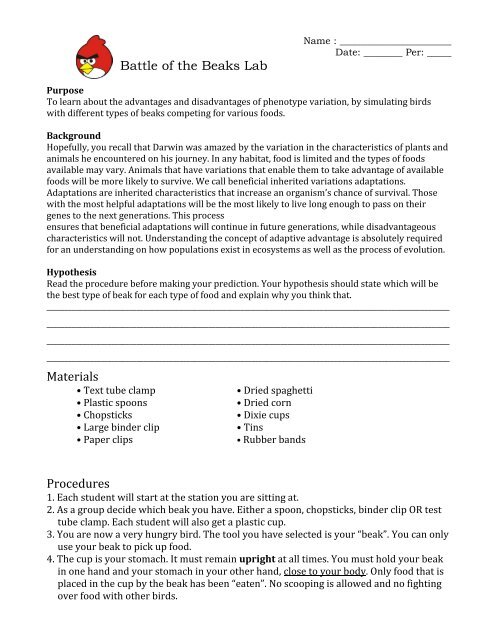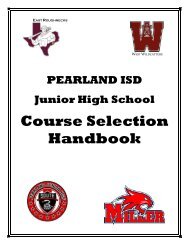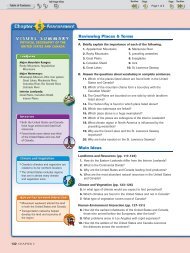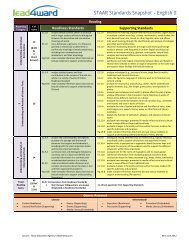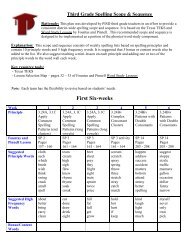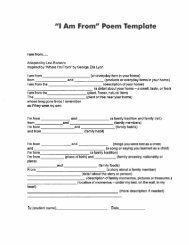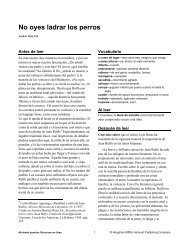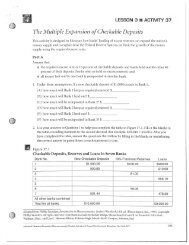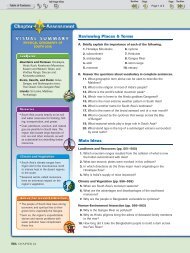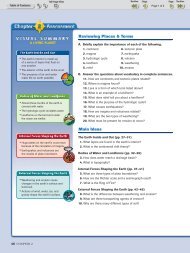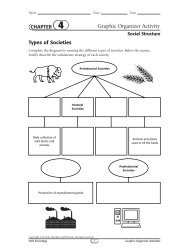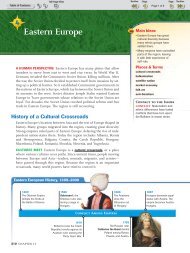Bird Beak Lab
Bird Beak Lab
Bird Beak Lab
Create successful ePaper yourself
Turn your PDF publications into a flip-book with our unique Google optimized e-Paper software.
Battle of the <strong>Beak</strong>s <strong>Lab</strong><br />
Name : _______________________<br />
Date: ________ Per: _____<br />
Purpose<br />
To learn about the advantages and disadvantages of phenotype variation, by simulating birds<br />
with different types of beaks competing for various foods.<br />
Background<br />
Hopefully, you recall that Darwin was amazed by the variation in the characteristics of plants and<br />
animals he encountered on his journey. In any habitat, food is limited and the types of foods<br />
available may vary. Animals that have variations that enable them to take advantage of available<br />
foods will be more likely to survive. We call beneficial inherited variations adaptations.<br />
Adaptations are inherited characteristics that increase an organism’s chance of survival. Those<br />
with the most helpful adaptations will be the most likely to live long enough to pass on their<br />
genes to the next generations. This process<br />
ensures that beneficial adaptations will continue in future generations, while disadvantageous<br />
characteristics will not. Understanding the concept of adaptive advantage is absolutely required<br />
for an understanding on how populations exist in ecosystems as well as the process of evolution.<br />
Hypothesis<br />
Read the procedure before making your prediction. Your hypothesis should state which will be<br />
the best type of beak for each type of food and explain why you think that.<br />
________________________________________________________________________________________________________________<br />
________________________________________________________________________________________________________________<br />
________________________________________________________________________________________________________________<br />
________________________________________________________________________________________________________________<br />
Materials<br />
• Text tube clamp<br />
• Plastic spoons<br />
• Chopsticks<br />
• Large binder clip<br />
• Paper clips<br />
• Dried spaghetti<br />
• Dried corn<br />
• Dixie cups<br />
• Tins<br />
• Rubber bands<br />
Procedures<br />
1. Each student will start at the station you are sitting at.<br />
2. As a group decide which beak you have. Either a spoon, chopsticks, binder clip OR test<br />
tube clamp. Each student will also get a plastic cup.<br />
3. You are now a very hungry bird. The tool you have selected is your “beak”. You can only<br />
use your beak to pick up food.<br />
4. The cup is your stomach. It must remain upright at all times. You must hold your beak<br />
in one hand and your stomach in your other hand, close to your body. Only food that is<br />
placed in the cup by the beak has been “eaten”. No scooping is allowed and no fighting<br />
over food with other birds.
5. When the teacher says “Go” you will have 30 seconds to feed (or until the food runs<br />
out). Collect as much food in your stomach as possible until the teacher says “Stop”.<br />
6. Anyone who is not responsible enough to maintain safe behavior at all times will<br />
no longer participate in the activity and will become an observer and receive a<br />
zero for this lab.<br />
7. When the teacher says “Stop”, students will empty their stomachs and count the<br />
contents. Record data in the Individual Data Table. Replace food items.<br />
8. When the teacher says to, rotate to a new station having a different food source.<br />
9. Continue steps 4-7 until all food items have been recorded.<br />
*Note: Make sure to put data in specially marked data table when you are at the “Variety<br />
Food” Station.<br />
Data<br />
Individual Data Paper Clips Dried Corn Rubber Bands Dried Spaghetti<br />
Type of <strong>Beak</strong>:<br />
Variety Food Station<br />
Individual Data Paper Clips Dried Corn Rubber Bands Dried Spaghetti<br />
Type of <strong>Beak</strong>:<br />
Class Data-Average the data together for each beak type<br />
<strong>Beak</strong> Type Paper Clips Dried Corn Rubber Bands Dried Spaghetti<br />
Test tube clamp<br />
Chopsticks<br />
Spoon<br />
Binder clip<br />
Graphing the Data<br />
1. In this experiment, what is the dependant variable? What is the independent variable?<br />
________________________________________________________________________________________________________________<br />
________________________________________________________________________________________________________________
2. Explain why it is better to use the data from the entire class averaged together when<br />
assessing results or creating a graph, rather than using only your own data.<br />
________________________________________________________________________________________________________________<br />
________________________________________________________________________________________________________________<br />
3. For this experiment, is it better to use a bar graph of a line graph to display the data?<br />
________________________________________________________________________________________________________________<br />
4. Create an appropriate graph for the class data for this experiment. Make sure the label<br />
the axis, make a key if needed, and use MOST of the graph.<br />
Analysis<br />
1. Which type of beak was best adapted to each type of food? Which beak was least<br />
adapted to each type of food?<br />
________________________________________________________________________________________________________________<br />
________________________________________________________________________________________________________________
2. What if the paper clips were high-protein beetles that were 4 times more nutritious<br />
than any of the other food items? How would your feeding strategy change?<br />
________________________________________________________________________________________________________________<br />
________________________________________________________________________________________________________________<br />
________________________________________________________________________________________________________________<br />
3. What would happen if all of the bird types in this activity flew to an island where no<br />
birds had been before and the only food available was dried corn? Which birds would<br />
be most successful? Which birds would be least successful?<br />
________________________________________________________________________________________________________________<br />
________________________________________________________________________________________________________________<br />
________________________________________________________________________________________________________________<br />
4. If we came back to this same island (from #5) in 50 years, what should we expect to<br />
see? (What type of birds will live on the island?)<br />
________________________________________________________________________________________________________________<br />
________________________________________________________________________________________________________________<br />
5. A river formed separating the bird into separate populations. This is a type of what<br />
isolation?<br />
________________________________________________________________________________________________________________<br />
6. Explain how the different birds species are an example of divergent evolution.<br />
________________________________________________________________________________________________________________<br />
________________________________________________________________________________________________________________<br />
________________________________________________________________________________________________________________<br />
7. Explain how this lab supports the theory of evolution.<br />
________________________________________________________________________________________________________________<br />
________________________________________________________________________________________________________________<br />
________________________________________________________________________________________________________________


